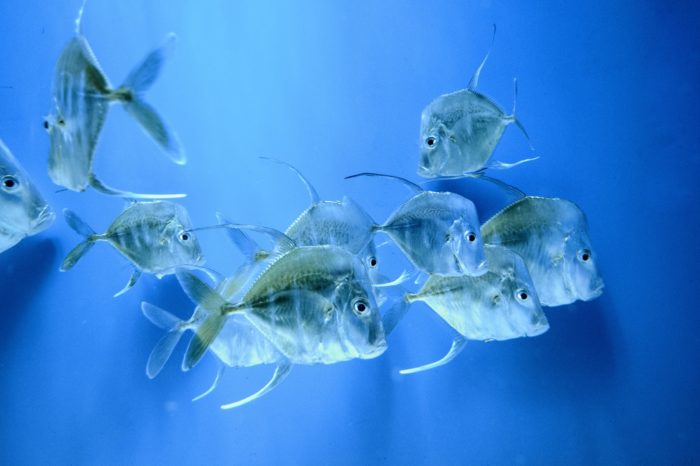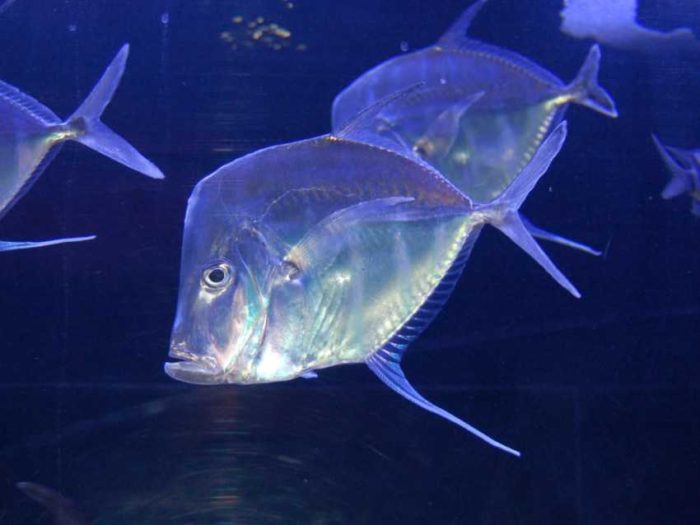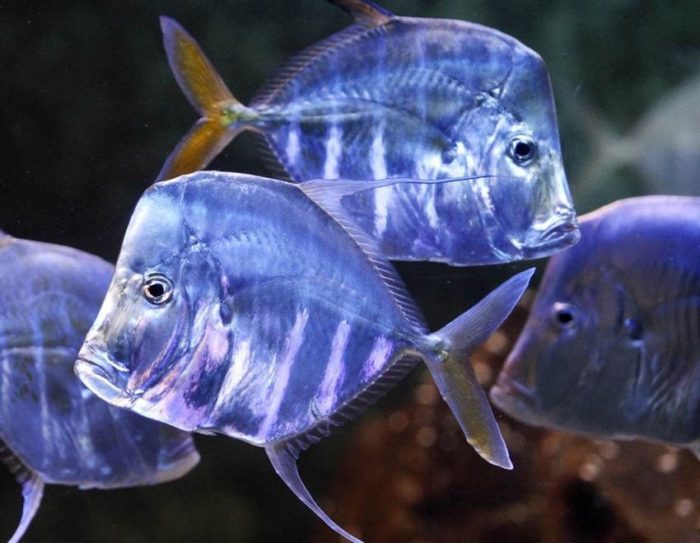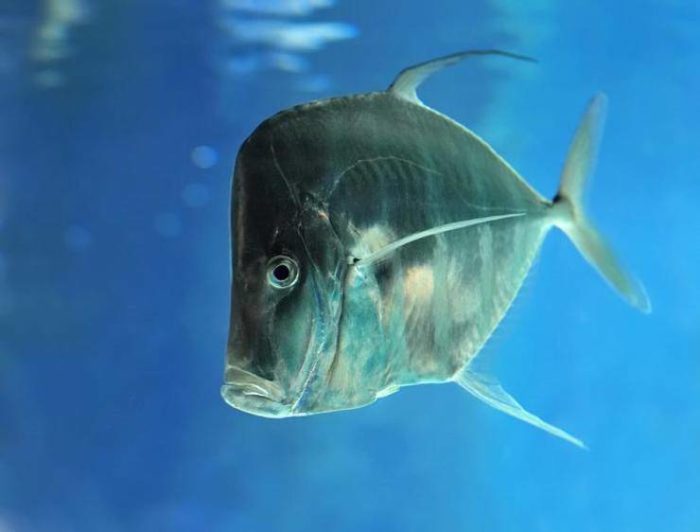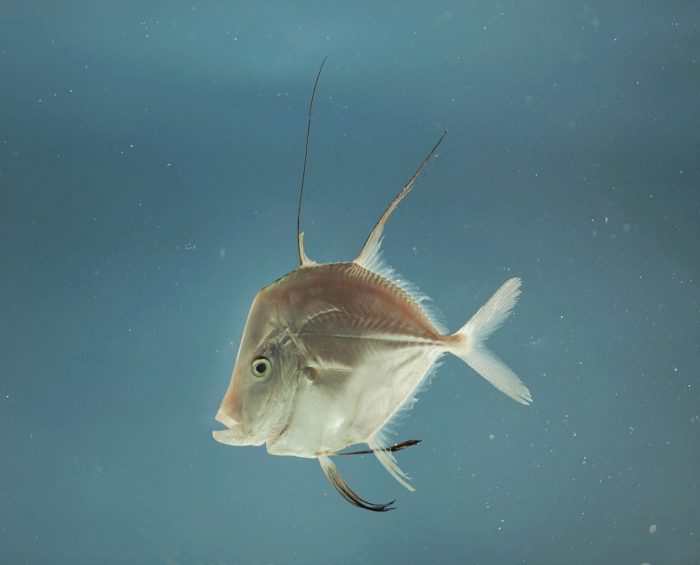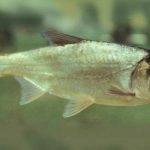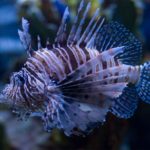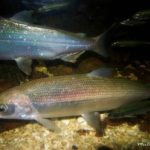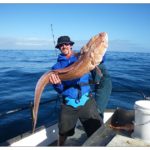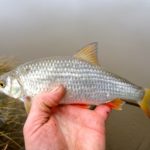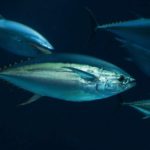Vomer is an unusual creature of marine fauna that deserves the attention of exotic lovers and fish gourmets. This aquatic inhabitant is not only attractive in its appearance, but also has a lot of useful properties that make it popular in many cuisines around the world. Although vomer is not as widely known as other sea varieties, its unique qualities attract the attention of chefs who are looking for unusual ingredients for cooking.
Description of the fish
The shade and size of vomeres differ depending on the subspecies.Their color varies from silver to golden with greenish. These fish are capable of reaching a maximum length of ninety centimeters, although more often there is information that their length does not exceed forty centimeters. An adult usually weighs about a kilogram.
Some fun facts about selenium:
- Some studies suggest that womer fish communicate with each other within a group by making quiet grunts. They can also make louder noises to scare away potential predators.
- Their ability to blend into their surroundings at a 45-degree angle makes them difficult to identify.
- The vomer's spine is unique due to its curved shape, it stretches from the pectoral fin to its very top.
- When selenium is caught at night, it has been found to have a luminescent glow and a moon-like shape, as evidenced by photographs taken by sailors who managed to catch it.
How does she look
The body of the vomer fish is flat, so it is difficult to notice if you look directly at it. The lower jaw protrudes slightly, which gives the vomer a slightly angry appearance. There is a silver rim around the voice, and the organs of vision themselves are located on both sides of the body. This allows you to successfully hide from predators, because where the vomer is found there are many of them.
The back has a curved shape with tiny, sharp fins. The lower part of the body is curved at a wide angle with long, narrow fins. The tail is small and transparent, distinguished by two V-shaped fins. There are no scales.
Habitat
Vomer fish have a structure similar to that of deep-sea creatures, but they do not dive deeper than sixty centimeters. They prefer silty and sandy substrates of Pacific and Atlantic waters.They are also present in the western European part of the Atlantic coastline. The juveniles move upriver into estuarine freshwater systems where there is more food for them.
Lifestyle
Selenes (the second name for vomer) live in flocks. The flock goes hunting at night. Their silvery hue and flattened body reflect light, allowing them to remain almost invisible to prey - small fish and fry. Small members of the school tend to hunt shrimp and crustaceans. Occasionally, they look for sea worms by burrowing in the sandy ocean floor. Large individuals use their compact but powerful teeth to break open shellfish shells before eating them.
Vomer has come up with a cunning tactic for catching prey that makes him virtually invisible. It throws itself at an angle of 45 degrees, which prevents potential victims from noticing the predator's approach and ensures that Selena's attacks are always successful.
Vomer fish reproduce in the summer through typical mating - the male fertilizes the female's eggs. However, all relatives of horse mackerel are completely negligent parents. They lay their eggs directly into the water and then swim away, leaving their countless eggs to fend for themselves. This makes her vulnerable to predators, since there is no one to protect her future offspring.
Due to difficult living conditions, newborn parents leave their eggs. Consequently, only one out of five thousand eggs survives and hatches into a fry.
The fry are saved by their transparency and ability to quickly evade danger. From birth they must acclimatize to the rigors of life at sea. It is these adaptive abilities that support the vomer population.Unfortunately, they have not learned to hide from predators like humans, which are capable of causing more damage than any marine threat.
Fishermen mainly target the largest fish, which leaves schools unprotected, putting their lives at risk. Some countries that have experienced declines have issued fishing bans and restrictions on how many can be caught each year. However, they have not yet been granted protected status.
It is difficult to obtain accurate numbers of fish in large groups due to the lack of a reliable method. A break from fishing allows baby fish to grow and reproduce, helping the population remain strong in the wild.
Recently, breeding of vomer for commercial use has become common. This certainly affects how many of them remain in nature. In their natural habitat they can live up to seven years.
For Russia, vomer is not a typical fish. It can be found either on the shelves of fish stores, as an exotic import, or in the aquariums of exotic lovers.
Useful and harmful properties
Vomer fish (sometimes mistakenly called boomer) contains proteins, fats, vitamins and minerals that make it useful for human nutrition. 100 grams of fresh vomer fish contain approximately 18 grams of protein, 4 grams of fat and 93 kilocalories. It also contains vitamins A, D, E, C and group B, as well as minerals including phosphorus, calcium, magnesium and iodine.
Despite the small amount of fat in vomer, it contains healthy Omega-3 fatty acids, which play an important role in maintaining heart and vascular health. The protein contained in meat is easily digestible and is used to build tissue and “repair” cells in the body.In addition, the minerals and vitamins contained in vomer are essential for maintaining healthy bones, teeth, nervous system and immune system.
Like any product, using vomer may have its own risks and limitations. So, it is worth remembering about:
- Allergic reactions. Some people are allergic to vomer fish and other seafood. When consuming selenium, you should monitor your body’s reaction.
- Accumulation of hazardous substances in meat. Vomer may contain mercury compounds, which reduce the absorption of nutrients in the body and can even lead to intoxication. Therefore, it is not recommended to consume vomer fish in large quantities.
In general, vomer fish is considered a healthy and nutritious food, but its consumption should be moderate and conscious, especially for people prone to allergies and women during pregnancy and breastfeeding.
Popular types
According to the classification, there are several separate varieties of vomer. Juveniles of Pacific and Atlantic species have different dorsal fin structures and are devoid of scales.
- The Peruvian variety is easily found in the waters off the east coast of the Pacific Ocean, reaching a maximum size of forty centimeters.
- African species live in waters from Peru to South Africa and are characterized by a standard size.
- Brevoorts swim in Pacific waters, reaching a length of forty centimeters.
- The Mexican womer lives along the coast of Mexico to Colombia, with adults not growing more than thirty-three centimeters.
- The Caribbean womer swims between the coasts of Mexico and Brazil and is considered the smallest member of its species, with a maximum length of two centimeters.
- Western Atlantic womer are sometimes mistaken for sunfish due to their large size compared to other members of the family. They reach sixty centimeters in length and weigh on average four and a half kilograms.
- An ordinary representative of the species lives in Canadian Atlantic waters and weighs about two kilograms in adulthood with a length of up to fifty centimeters.
How to cook fish
Vomer is prepared in various ways, for example, on the grill, which helps to reveal all the richness of taste. This fish with a bulging forehead is also baked in the oven, stewed and boiled. However, smoking remains the most popular method.
Captive-bred womer do not grow as large as those found in the wild, but they are less expensive due to their smaller size. The Ecuadorians are lucky because they catch selenium fish, which are not only large, but also high in protein. Peruvians usually eat vomer fish, cooked in a baked form.
A delicious recipe for baked vomer on a bed of vegetables. Ingredients:
- 1 kg of vomer fish.
- 2 carrots.
- 2 bows.
- 2 bell peppers.
- 2 tomatoes.
- 4 cloves of garlic.
- 50 ml olive oil.
- 1 lemon.
- 2 sprigs of rosemary.
- Salt and pepper to taste.
Step-by-step instruction:
- The first step is to rinse the fish under cold water, remove the scales, entrails and head. Then trim the tail and separate the fillet from the bones.
- Peel the vegetables and cut into large pieces. Finely chop the garlic.
- Salt and pepper the fillet, put it in the refrigerator for 15 minutes to soak in the spices.
- Take a large baking sheet and line it with foil or parchment paper. Place the vegetables in the bottom of the baking tray and add the rosemary and garlic.
- Distribute the vegetables evenly on the baking sheet, place the fillets on them, and place lemon slices on top.
- Drizzle everything with olive oil and season to taste with salt and pepper.
- Bake in a preheated oven at 180 degrees for 30-40 minutes until the fish is golden and soft to the touch.
During hot smoking
Smoking is an ancient method of preparing fish, which allows you to preserve its taste and aroma for a long time. Here is a recipe for preparing this sea creature by hot smoking:
Ingredients:
- 1-2 vomer fish (depending on size).
- 1 tablespoon salt.
- 1 tablespoon brown sugar.
- 1 teaspoon red or black pepper.
- Needles (or special wood chips for smoking).
How to cook:
- Clean the vomer fish from scales and entrails, leaving only the meat.
- In a large bowl, combine salt, brown sugar and pepper.
- Dredge the fish in the salt and spice mixture, covering it evenly on all sides.
- Leave the fish for 30-40 minutes so that it is saturated with the aroma of spices.
- Turn on the smokehouse and fill it with pine needles (or shavings). Wait until it lights up and starts to smoke.
- Place the fish on the smoker grate and close the lid.
- Smoke vomer fish at 80-100 degrees Celsius for 1-2 hours, depending on the size of the fish. At this temperature, the carcass should be ready and saturated with the aroma of pine needles.
- Serve the finished fish hot or cold, with lemon and herbs.
When cold
Hot and cold smoking are two different ways of preparing fish.The main difference between them is the temperature and duration of the process.
Hot involves processing fish at high temperatures, approximately 70 to 80 degrees Celsius. This process not only smokes but also cooks the fish so that it is soft and juicy. Usually hot smoking is carried out over several hours. Cold weather occurs at temperatures much lower, usually in the range of 20 to 30 degrees Celsius. The fish is smoked for 12-48 hours. As a result, the carcass receives an intense aroma and taste.
How to prepare cold smoked selenium:
- The vomer fish is gutted, washed and dried on a towel. A mixture of crushed bay leaves, pepper and salt is applied on top of the fish.
- The salted vomer fish is then placed in a container to marinate for five to six days.
- After this, the vomer is removed from the salt mixture and soaked in water, and then hung in a well-ventilated area to dry for one day.
- Finally, they are strung on a cord and smoked continuously at 25 degrees Celsius in a smokehouse for about five days.
How to store
Frozen vomer can be stored in industrial freezers at a temperature not exceeding -18 degrees Celsius for up to eight months. During this long storage period, it is recommended to wrap food in insulating material such as tarpaulin or film.
In grocery stores, frozen vomer fish is stored at a temperature of -5-6 degrees Celsius for no more than two weeks, and in the absence of refrigeration chambers it cannot be stored for more than one day.
As for smoked products, they retain their taste in the refrigerator for five days, and when cold smoked - up to fourteen days.
If product handling protocols are not followed in the supply chain, then product defects are bound to occur. Typical ones include:
- dehydration of fillets, causing loss of color, toughness of meat, breakdown of fats and unpleasant odor;
- deformation of the carcass due to untimely turning during freezing or storage in heaps, which leads to thawing.
The best places to buy vomer are fresh fish markets located in coastal cities. Unfortunately, this is not an option for our area. Frozen vomer fish carcasses can be found in Russian stores and supermarkets. Hot and cold smoked vomers are available as an accompaniment to beer. Prices for fresh frozen raw materials vary from 400 rubles. per kilogram, while smoked products cost from 800.
Fishing
The Atlantic fishery is not extensive, but commercial fishing for Pacific species, especially the Peruvian variety, predominates. The unusual shape and appearance of these fish have aroused interest among amateur aquarists who are trying to breed them artificially. This enthusiasm has caused a decline in the numbers of small Atlantic seleniums, especially in Eastern European waters.
Vomer is completely safe for humans, and any rumors that it is poisonous turned out to be false. The confusion most likely stems from the similarity of its name to selenium, a highly toxic element second only to arsenic in toxicity.
The vomer requires a large space for swimming, as well as a large aquarium with good circulation and high-quality filtration. Small containers are not suitable for keeping vomer fish.
In addition, the vomer is a predator; it will happily eat small fish that you place in the same aquarium.It also requires a special diet and certain conditions of detention, which are not so easy to organize in a home aquarium.
If you decide to keep selenium at home, then purchase a spacious aquarium in which the vomer fish will feel comfortable, and also take care of a special diet for this marine inhabitant.

